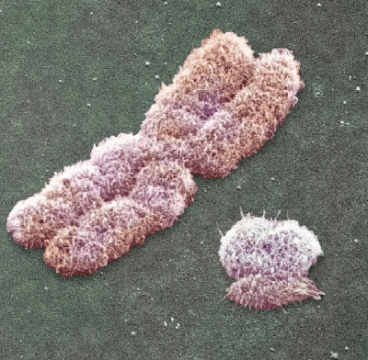 This post is about serendipity.
This post is about serendipity.
In the historical methods class, we’ve been using Williams, Historian’s Toolbox as our guide to methodology, and in his chapter on Sources, he discusses non-documentary historical evidence, including artifacts, archaeology, and genetic/forensic evidence. His case study was the historical controversy over the paternity of the children of Monticello slave Sally Hemings, and how genetic evidence (DNA analysis of male descendants, conducted in 1998) had totally changed the conversation because the scientific evidence overwhelmingly pointed to a genetic relationship between Jefferson and Hemings. In reproducing the genetic results, Williams made the mistake of captioning the image: “For Genetics Students Only!”
Now, that got my dander up. Big time, in fact. True, as a Ph.D.-holding historian I could not make head nor tails out of the results. But I resented being told that it was “off limits” for me or my students. As if only genetics students could or should take it on. Besides, I started college as a biochem/genetics major – I’m one of those midstream major-changers whose life took a totally different direction than I imagined it would – and so I can appreciate when science and history cross paths.
Fortunately our genetics professor here on campus is a good friend of mine and I thought he might be game to come be a guest in my class to help interpret the data with us. Better yet, it turns out he teaches a genetics class in the same time slot as my historical methods class, and they were just about to start a unit on genetic linkages, and the Jefferson-Hemings DNA results could be a good way to introduce that concept to his class, so he proposed joining our classes for a session. I would talk about the stakes in the debate and the implications for historical interpretation, and he would explain the genetics results for both my students and his own. Shazam!
I had one weekend to get up to speed on the debate and choose readings for my students so they would have a solid background for the discussion. I also decided to make a handout for the combined class: on one side, the family tree of the descendants of Betsy Hemings (from Gordon-Reed, The Hemingses of Monticello, 2009), and on the other, a transcript of Jefferson’s 1815 letter about the legal definition of mulatto, showing his early 19th-century scientific notation for genetic crosses which I thought would be of interest to the genetics students (from the appendix of Lewis & Onuf, Sally Hemings and Thomas Jefferson: History, Memory and Civic Culture, 1999). This isn’t an area of my own research and in fact I would have described my prior knowledge as “dim,” so it was a fascinating weekend. I tried to anticipate what students would ask (e.g. why they had to use descendants of TJ’s uncle rather than TJ himself) and to prepare rather broadly instead of writing a structured lecture presentation.
Our class meeting followed on Presidents Day, so we started with a short discussion of how “Presidents” get flattened into 2-D car salesmen and how their humanity and historical context get totally lost in American commercial culture, and how the scientific evidence (despite the refusal of some so-called historians to accept its results) helps us restore the humanity of these families and a fuller understanding of their place and times. Then my colleague talked about the Y chromosome (it’s that little squishy ball in the electron microscope image), and about linkages, and how to interpret the lines of numbers in the published results (Eugene Foster et al, “Jefferson Fathered Slave’s Last Child,†Nature Vol 396, 5 November 1998). Students asked a lot of good questions–students from both classes. We went back and forth giving the answers for about half an hour, and then my class and I trooped back to our own classroom to continue our discussion about historical interpretation and debate.
All in all I consider the experiment a roaring success. Team-teaching does not happen at our institution: there are both structural and cultural obstacles too numerous to mention here, but although small-scale, this was a great opportunity for both profs, and I hope the students benefited from seeing how the two fields’ knowledge can be integrated. I hope that the modeling we did had an impression, too – that scholarship is collaborative, open to inquiry, and willing to take some risks.
(Image: from MIT News; it’s the top Google image under the search term “Y chromosome.” )













